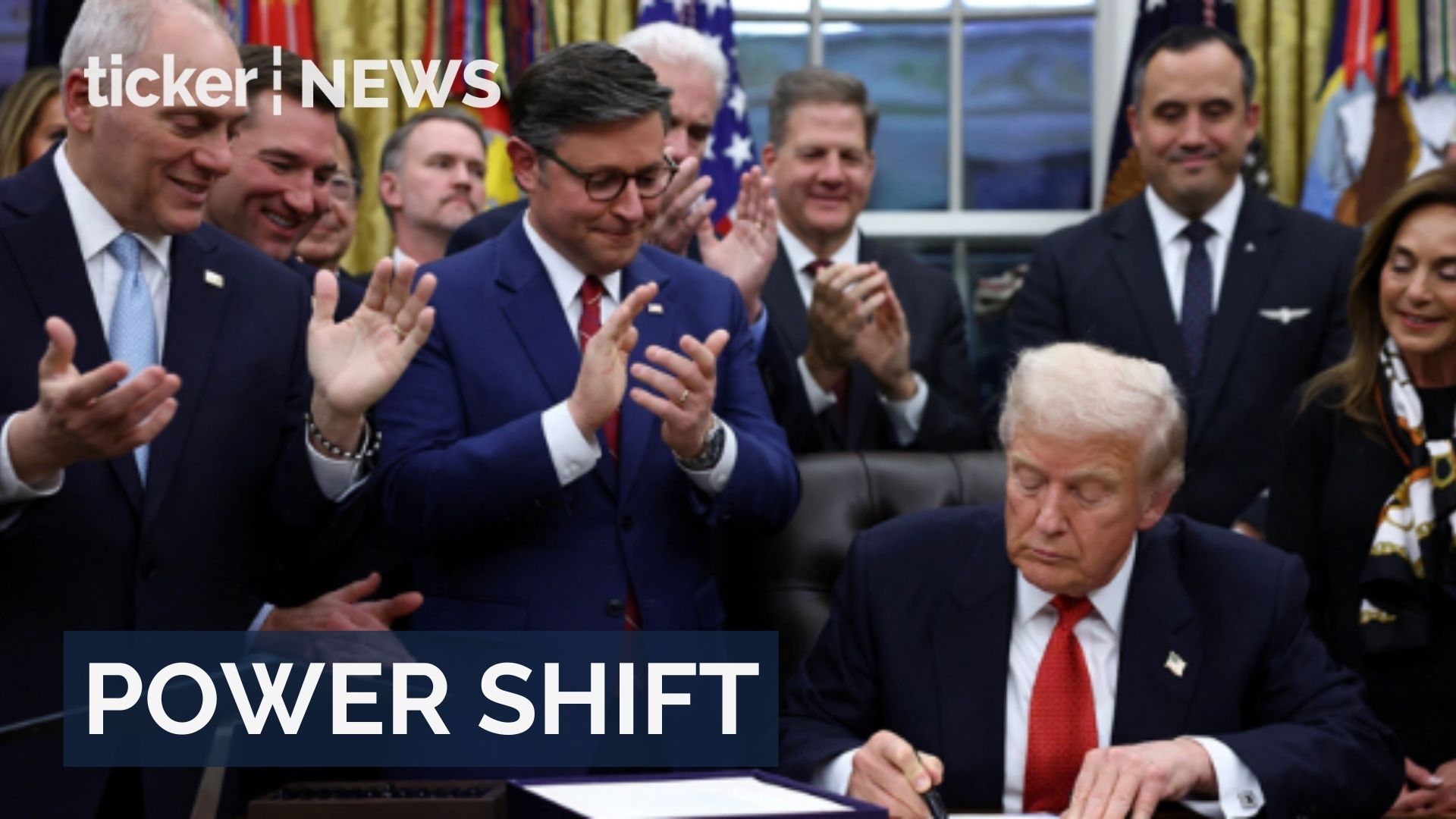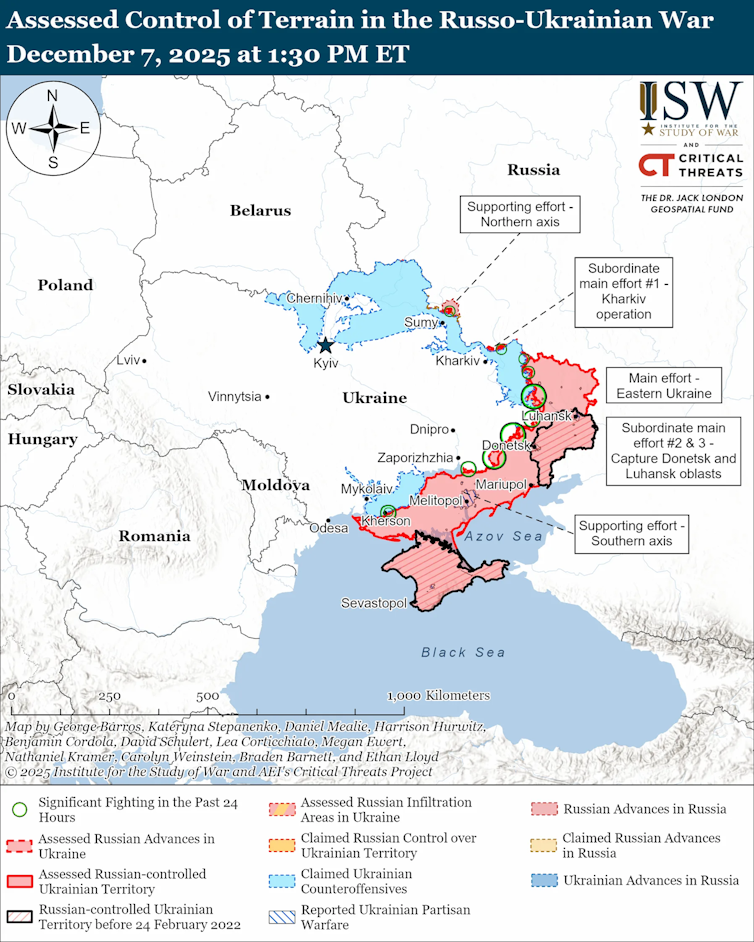Matthew Sussex, Australian National University
The iconoclastic American general Douglas Macarthur once said that “wars are never won in the past”.
That sentiment certainly seemed to ring true following Ukraine’s recent audacious attack on Russia’s strategic bomber fleet, using small, cheap drones housed in wooden pods and transported near Russian airfields in trucks.
The synchronised operation targeted Russian Air Force planes as far away as Irkutsk – more than 5,000 kilometres from Ukraine. Early reports suggest around a third of Russia’s long-range bombers were either destroyed or badly damaged. Russian military bloggers have put the estimated losses lower, but agree the attack was catastrophic for the Russian Air Force, which has struggled to adapt to Ukrainian tactics.
This particular attack was reportedly 18 months in the making. To keep it secret was an extraordinary feat. Notably, Kyiv did not inform the United States that the attack was in the offing. The Ukrainians judged – perhaps understandably – that sharing intelligence on their plans could have alerted the Kremlin in relatively short order.
Ukraine’s success once again demonstrates that its armed forces and intelligence services are the modern masters of battlefield innovation and operational security.
Finding new solutions
Western military planners have been carefully studying Ukraine’s successes ever since its forces managed to blunt Russia’s initial onslaught deep into its territory in early 2022, and then launched a stunning counteroffensive that drove the Russian invaders back towards their original starting positions.
There have been other lessons, too, about how the apparently weak can stand up to the strong. These include:
- attacks on Russian President Vladimir Putin’s vanity project, the Kerch Bridge, linking the Russian mainland to occupied Crimea (the last assault occurred just days ago)
- the relentless targeting of Russia’s oil and gas infrastructure with drones
- attacks against targets in Moscow to remind the Russian populace about the war, and
- its incursion into the Kursk region, which saw Ukrainian forces capture around 1,000 square kilometres of Russian territory.
On each occasion, Western defence analysts have questioned the wisdom of Kyiv’s moves.
Why invade Russia using your best troops when Moscow’s forces continue laying waste to cities in Ukraine?
Why hit Russia’s energy infrastructure if it doesn’t markedly impede the battlefield mobility of Russian forces?
And why attack symbolic targets like bridges when it could provoke Putin into dangerous “escalation”?
The answer to this is the key to effective innovation during wartime. Ukraine’s defence and security planners have interpreted their missions – and their best possible outcomes – far more accurately than conventional wisdom would have thought.
Above all, they have focused on winning the war they are in, rather than those of the past. This means:
- using technological advancements to force the Russians to change their tactics
- shaping the information environment to promote their narratives and keep vital Western aid flowing, and
- deploying surprise attacks not just as ways to boost public morale, but also to impose disproportionate costs on the Russian state.
The impact of Ukraine’s drone attack
In doing so, Ukraine has had an eye for strategic effects. As the smaller nation reliant on international support, this has been the only logical choice.
Putin has been prepared to commit a virtually inexhaustible supply of expendable cannon fodder to continue his country’s war ad infinitum. Russia has typically won its wars this way – by attrition – albeit at a tremendous human and material cost.
That said, Ukraine’s most recent surprise attack does not change the overall contours of the war. The only person with the ability to end it is Putin himself.
That’s why Ukraine is putting as much pressure as possible on his regime, as well as domestic and international perceptions of it. It is key to Ukraine’s theory of victory.
This is also why the latest drone attack is so significant. Russia needs its long-range bomber fleet, not just to fire conventional cruise missiles at Ukrainian civilian and infrastructure targets, but as aerial delivery systems for its strategic nuclear arsenal.
The destruction of even a small portion of Russia’s deterrence capability has the potential to affect its nuclear strategy. It has increasingly relied on this strategy to threaten the West.
A second impact of the attack is psychological. The drone attacks are more likely to enrage Putin than bring him to the bargaining table. However, they reinforce to the Russian military that there are few places – even on its own soil – that its air force can act with operational impunity.
The surprise attacks also provide a shot in the arm domestically, reminding Ukrainians they remain very much in the fight.
Finally, the drone attacks send a signal to Western leaders. US President Donald Trump and Vice President JD Vance, for instance, have gone to great lengths to tell the world that Ukraine is weak and has “no cards”. This action shows Kyiv does indeed have some powerful cards to play.
That may, of course, backfire: after all, Trump is acutely sensitive to being made to look a fool. He may look unkindly at resuming military aid to Ukraine after being shown up for saying Ukrainian President Volodymyr Zelensky would be forced to capitulate without US support.
But Trump’s own hubris has already done that for him. His regular claims that a peace deal is just weeks away have gone beyond wishful thinking and are now monotonous.
Unsurprisingly, Trump’s reluctance to put anything approaching serious pressure on Putin has merely incentivised the Russian leader to string the process along.
Indeed, Putin’s insistence on a maximalist victory, requiring Ukrainian demobilisation and disarmament without any security guarantees for Kyiv, is not diplomacy at all. It is merely the reiteration of the same unworkable demands he has made since even before Russia’s full-scale invasion in February 2022.
However, Ukraine’s ability to smuggle drones undetected onto an opponent’s territory, and then unleash them all together, will pose headaches for Ukraine’s friends, as well as its enemies.
That’s because it makes domestic intelligence and policing part of any effective defence posture. It is a contingency democracies will have to plan for, just as much as authoritarian regimes, who are also learning from Ukraine’s lessons.
In other words, while the attack has shown up Russia’s domestic security services for failing to uncover the plan, Western security elites, as well as authoritarian ones, will now be wondering whether their own security apparatuses would be up to the job.
The drone strikes will also likely lead to questions about how useful it is to invest in high-end and extraordinarily expensive weapons systems when they can be vulnerable. The Security Service of Ukraine estimates the damage cost Russia US$7 billion (A$10.9 billion). Ukraine’s drones, by comparison, cost a couple of thousand dollars each.
At the very least, coming up with a suitable response to those challenges will require significant thought and effort. But as Ukraine has repeatedly shown us, you can’t win wars in the past.
Matthew Sussex, Associate Professor (Adj), Griffith Asia Institute; and Fellow, Strategic and Defence Studies Centre, Australian National University
This article is republished from The Conversation under a Creative Commons license. Read the original article.

























